25.10.2004
M.Dvoretsky. Positional sacrifice of the Queen (continuation 2)
Considering a sacrifice of the Queen "almost for nothing" (for one or two pawns or only one light piece) chess player either calculates variants till a checkmate or revenge of the material, or hesitates over a combination, because the risk is great. The work of art by Nezhmetdinov is a very rare exception as well as the next remarkable game.
Inarkiev – Motylev B72
Moscow 2002
1.e2-e4 c7-c5
2.¤g1-f3 d7-d6
3.d2-d4 c5:d4
4.¤f3:d4 ¤g8-f6
5.¤b1-c3 g7-g6
6.Ґc1-e3 Ґf8-g7
7.Ґf1-e2 0-0
8.f2-f4 ¤b8-c6
9.¤d4-b3 Ґc8-e6
10.Ґe2-f3?!
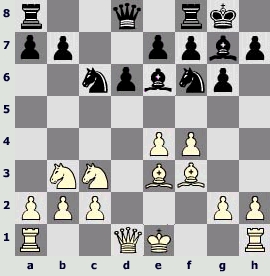
Theoretical continuations are 10.0-0 and 10.g4. The move in the game is doubtful, because Black, having moved the Bishop to c4, hinders the opponent from the castling. It's a question, whether Black is to move a7-a5 and a2-a4 – it's not easy to estimate into the hands of whom it will play.
10. . . . a7-a5!?
In the game Rauser – Lisitsin, championship of the USSR, Leningrad 1933 it was played 10...Ґc4 11.Јd2 [to 11.g4, it would probably be 11...d5] 11...¦c8, and now White would think about 12.0-0-0!? (instead of chosen 12.¦d1).
11.a2-a4 Ґe6-c4!
12.Јd1-d2?!
12.¤d5? ¤:d5 13.ed ¤b4 are bad.
If 12.g4, then 12...d5!? 13.e5 [13.¤:d5? ¤:d5 14.ed ¤b4µ], and now either 13...¤:g4!? 14.Ґ:g4 Ґ:b3 15.cb d4 16.Ґf2 dc 17.bc g5!?›, or 13...Ґ:b3 14.cb d4 15.Ґ:c6 bc 16.Ґ:d4 ¤:g4 17.Ґc5›. In these variants some weakening of the Queen side by the move a2-a4, perhaps, increases a little the chance of Black, although this is not very important.
But then White has got the resource that was lacking in case of immediate 10...Ґc4: he could play 12.¤d2!? Ґa6 13.¤b5›, preparing a short castling (pointed out by Alexander Motylev).
12. . . . Јd8-c8!
It's a broad-spectrum move. Black hinders the long castling (13.0-0-0? Ґ:b3 14.cb Јe6µ – here the moves of the "а"-pawns obviously proved useful to him), and at the same time takes an important square g4 under his control: prevents g2-g4 and prepares ¤g4.
13.¤b3-d4 ¤f6-g4
14.¤d4:c6
If 14.Ґg1, then 14...¤:d4 15.Ґ:d4 e5! (Motylev).
14. . . . b7:c6
15.Ґe3-g1 ¦a8-b8
15...f5!? deserved attention.
16.b2-b3 Ґc4-a6

17.¦a1-b1?
It's an unsuccessful move. The position of the Rook would be better at d1. A desperate 17.0-0-0!? was also worthy of thinking.
17. . . . f7-f5!
17...e5?! 18.h3 ¤f6 19.fe de 20.Ґe3 are far weaker with subsequent ¤e2 and 0-0 – White managed to stabilize the situation (Motylev).
18.e4:f5 Јc8:f5
19.h2-h3 ¤g4-h6
20.Ґg1-e3
Incaseof 20.Ґ:c6? Black has a pleasant choice between 20...¦bc8 21.¤d5 Јe6+ 22.Јe3 ўf7! 23.Ј:e6+ ў:e6° (Dvoretsky) and 20...Ј:f4 counting on 21.Ј:f4 [21.Ґf3µ is better] 21...Ґ:c3+ 22.Јd2 ¦f1# (Motylev).
20. . . . e7-e5!
20...d5?! 21.¤e2 are worse.
21.g2-g4
It's the only move.
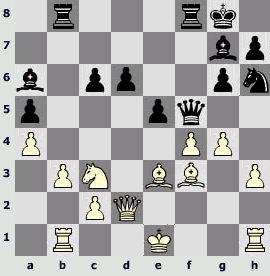
Both chess players were striving towards this position. In case of the Queen's retreat the Knight h6 gets under the blow h6: 21...Јd7 22.f5 ¤f7 [22...¤:f5 23.gf gf 24.Ґh6! don't work with advantage of White] 23.¤e4!?, and the situation becomes double-edged. However Motylev has prepared a surprise: a fantastic sacrifice of the Queen merely for a Bishop!
21. . . . e5:f4!!
22.g4:f5 f4:e3
23.Јd2:e3 ¤h6:f5!
23...¦be8?! 24.¤e4 are far weaker.
24.Јe3-e6+
In case of 24.Јd2 Black would win by means of 24...¦be8+ 25.ўd1 [25.¤e2 ¤g3] 25...¤e3+ 26.ўc1 ¦:f3 27.¦e1 Ґh6! [27...d5!?] 28.¤d1 [28.ўb2 ¤c4+] 28...¦f1! 29.¦:f1 Ґ:f1 with inevitable threat 30...¤f5 (Motylev).
24. . . . ўg8-h8
25.¤c3-e2
To 25.Ґ:c6 there is 25...Ґ:c3+ 26.ўd1 ¦f6! [but not 26...¤d4? 27.Јe3] 27.Јe4 d5 [27...¦bf8 is also strong] 28.Ґ:d5 ¦d8° (Motylev).
25. . . . ¦b8-e8

26.Јe6:e8
Although White moves the Queen back, the appeared position turns out to be absolutely hopeless. Probably he should have tried 26.Јd7!? Ґ:e2 [26...¤d4? 27.0-0! are not correct] 27.Ґ:e2 ¤g3 [27...¤d4 28.¦h2 ¤:e2 do not work (in the hope of checkmate after 29.¦:e2? Ґc3+) because of 29.Ј:e8! ¦:e8 30.¦:e2±] 28.Ј:c6! [28.¦h2 Ґc3+ 29.ўd1 ¦f1+! 30.Ґ:f1 ¦e1#] 28...¤:e2 [it's unclear 28...¦:e2+ 29.ўd1] 29.ўd1 [29.ўd2!? Ґh6+ 30.ўd1 ¦e3, planning depending on circumstances ¤c3+; ¤g3; ¦fe8; d5-d4] 29...¤c3+ 30.ўc1 ¤a2+ 31.ўd1 ¦e5, and Black keeps a severe attack.
26. . . . ¦f8:e8
Although White has an exchange for a pawn, his position is bad because the pieces are detached and the King is endangered as before. As soon as the Bishop a6 joins the play (after inevitable d6-d5), two Bishops will activate.
27.c2-c4 ¤f5-d4
27...d5 28.ўf2 Ґf8 are also not bad or 28...Ґf6.
28.ўe1-f2 ¤d4:f3!
It's useful for Black's white square Bishop to exchange the opponent.
29.ўf2:f3 d6-d5!
30.¦b1-c1 d5-d4
Here and later on Black has a few ways to act. For example 30...Ґh6 31.¦c3 c5 or 30...¦b8.
31.¦h1-d1 c6-c5
32.¦d1-d3 Ґg7-h6
32...Ґb7+ 33.ўf2 Ґe4.
33.¦c1-e1
33.¦f1 Ґb7+ 34.ўf2 Ґe4 35.¦g3 Ґc2° (Motylev).
33. . . . Ґa6-b7+
33...Ґc8!?
34.ўf3-g3 ўh8-g8
35.h3-h4 ¦e8-e5
36.ўg3-f2 Ґh6-e3+
37.ўf2-g3 g6-g5!
Certainly not 37...¦f5? 38.¦:e3! de 39.¤f4і.
38.h4:g5 ¦f5:g5+
39.ўg3-h4 ¦g5-e5!
40.ўh4-g3
40.¤g3 Ґg5+.
40. . . . h7-h6!?
41.¤e2-g1
41.¤c1 ¦g5+ 42.ўh2 Ґf4+ 43.ўh3 Ґc8+ 44.ўh4 ўg7!°; 41.¦f1 ¦g5+ 42.ўh4 Ґe4° (Motylev).
41. . . . ¦e5-g5+
42.ўg3-h2 ¦g5-h5+
43.ўh2-g3
In case of 43.¤h3 there could be a won pawn ending: 43...Ґc8 44.¦e:e3 de 45.¦:e3 [45.¦d8+ ўf7 46.¦:c8 e2] 45...ўf7 46.ўg2 ¦:h3°.
43. . . . ¦h5-g5+
44.ўg3-h2 Ґe3-f2!
45.¦d1-f1 ¦g5-g2+
46.ўh2-h3 Ґf2:g1
47.b3-b4 c5:b4
48.c4-c5 Ґg1-e3
49.¦f1-f6 ¦g2-g1
50.c5-c6 Ґb7-c8+
51.ўh3-h2 ¦g1-c1
52.¦d3-b3 ўg8-g7
White resigned.
Here is another example of sacrifice of Queen for a mere light piece.
Yanovsky – Lasker C48
Cambridge-Springs 1904
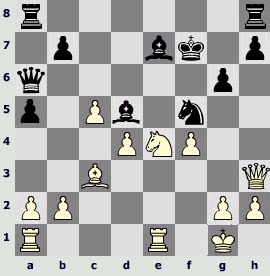
In the important for both chess players competition of the last round David Yanovsky had a won position, but a few moves earlier he had made an unfortunate choice and let the opponent activate.
25.g2-g4!
"The advantage of Black is now indisputable. Unwilling to agree to that Yanovsky made a desperate attempt that only hastened his loss" (V.Zak).
White had been buried by that moment also by other commentators. Ithinkit had been too early. Yes, there was a sudden change in the character of the struggle, the position of Black improved considerably; his light pieces are disposed perfectly now. But White has three pawns for a piece, the black King is open and takes the risk of being attacked.
It's possible for example to suggest the exchange: 25.¤g5+!?. However the move made by Yanovsky is more logical. Heavy pieces of the opponent are still out of play and before they come into the struggle White forces the events though at the cost of weakening his King's shelter.
25. . . . ¤f5-h4
26.¤e4-d6+ ўf7-f8?!
26...Ґ:d6! 27.Ј:h4 Ґf8 28.¦e5 Јc6 29.f5 ўg8іwould be better and safer.
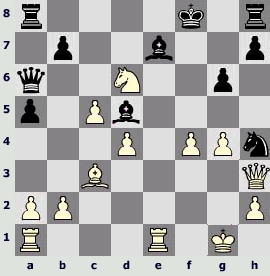
27.¦e1:e7!
"Yanovsky at the sight of the ruin of his hopes decided to sacrifice the Queen. But also in case of 27.ўf2 g5 [27...Ґ:d6 28.cd g5 29.fg ¤g6› (Dvoretsky)] 28.fg ¤g6 29.Јh6+ ўg8 it was impossible to keep the position of Black" (B.Weinstein).
Insteadof 28.fg? we'llplay 28.¦:e7! ў:e7 29.Јe3+ ўd7 30.Јe5. An exceptional accuracy is now required of Black to avoid a defeat. Thebestdefense is 30...¦hf8! 31.f5 Ґf7! [31...Ґg8? 32.Јg7+ ўc6 33.Ґ:a5!ќ] 32.¦e1 ¦ae8 33.¤:e8 ¦:e8 34.Јg7 ¦:e1 35.Ґ:e1 Јc4 36.Ґd2, and a draw is most probable.
However the sacrifice of the Queen was even stronger and could have passed again the advantage to White.
27. . . . ¤h4-f3+
28.Јh3:f3!
Certainly not 28.ўf2? ў:e7 29.Јh6 ¦af8 with subsequent ўd8.
28. . . . Ґd5:f3

29.¦e7-f7+?
Here is the decisive mistake! It was necessary to play 29.¦ae1! Ґd5 [29...Ґ:g4? 30.d5ќ; 29...Јc6!? 30.f5] 30.f5, and after either 30...gf 31.¦7e5! or 30...g5 31.f6 Јc6 32.f7 it will turn out badly for the black King.
29. . . . ўf8-g8
30.d4-d5
If 30.¦e1, then 30...Ґd5 (with tempo!), and to 31.¦c7, probably, 31...b5!, planning to harass the black square Bishop.
30. ... Ґf3:d5
31.¦f7-g7+ ўg8-f8
32.¦a1-e1 Јa6-c6
Black accentuates the only, but quite serious minus of the way of attacking, chosen by the opponent. It`s a vulnerability of the important pawn с5. In case of 33.Ґd4, 33...Јa4! turns the scale.
33.b2-b4 ¦a8-d8
Another way to reach the aim is: 33...ab! 34.Ґd4 ¦:a2 35.¦ee7 ¦g2+ 36.ўf1 Јa6+ 37.ўe1 ¦g1+! 38.Ґ:g1 Јa1+.
34.Ґc3-d4
If 34.¦:b7, then either 34...ab, or 34...¦:d6 35.¦b8+ ўf7 36.¦:h8 ¦e6 37.¦:h7+ ўe8 38.¦h8+ ўd7 39.¦h7+ ўc8 40.¦h8+ ўb7 41.¦b1 Јb5°.
34. . . . ¦d8:d6
35.c5:d6
35.b5 Јc8!° [but not 35...Ј:b5 36.cd Јb4?? 37.¦e8+!]. Now the last hope of White is pinned on 35...Јc2?? 36.¦e8+! ў:e8 37.d7+.
35. . . . Ґd5-h1!
White resigned (36.¦e2 Јc1+ 37.ўf2 Ј:f4+).
In the next two games one of the important factors that compensate sacrifice of the Queen for two light pieces was a far advanced passed pawn in the centre.
Sakaev – Rublevsky D21
Championship of Russia, St.Petersburg 1998
1.d2-d4 d7-d5
2.¤g1-f3 e7-e6
3.c2-c4 d5:c4
4.Јd1-a4+ ¤b8-d7
5.e2-e4 c7-c5
5...¤gf6 6.¤c3 [6.Ґg5!?] 6...a6 7.Ґ:c4 ¦b8 can also be found.
6.Ґf1:c4 c5:d4
7.0-0!
7.¤:d4 Ґc5 8.¤b3 Ґd6= promise nothing (А.Huzman).
7. . . . Ґf8-c5
To 7...Јb6 there is the strongest response 8.¤a3! ¤e7 9.¤b5 with initiative of White (Sakaev – Khalifman, Russia 1997 69/359).
8.b2-b4!
As two games, which were played in the Championship of the USSR 1997 in Elista between Sergej Ivanov (White) and Sergej Rublevsky, showed 8.¤a3 ¤e7 led only to equality. In one of them there was 9.¤b5 ¤b6 10.Јc2 ¤:c4 11.Ј:c4 Ґb6=, in the other there was: 9.b4 Ґd6 10.¤b5 Ґb8 11.¤b:d4 0-0=.
8. . . . Ґc5-d6!?
8...Ґb6!? is also possible, in response to this Konstantin Sakaev recommends 9.¦d1.
9.e4-e5 Ґd6-b8
10.Ґc1-f4
The attempt to capture the space at the King side by means of 10.h4?! ¤e7 11.h5 mentioned by Sakaev in the commentary is dubious. Black responds by either 11...¤c6, or 11...0-0 12.¦e1 ¤c6 13.Ґf4 ¤b6 14.Јb3 ¤:c4 15.Ј:c4 Јd5 with a perfect play.
10. . . . ¤g8-e7
11.¤b1-d2 0-0
12.¦f1-e1 ¤d7-b6
There is an interesting recommendation of Vladimir Epishin: 12...a5!? 13.Ґd3 b5 14.Ґ:b5 ¤b6 15.Јb3 ab. Let's continue the variant: 16.Ј:b4 ¤bd5 17.Ј:d4 Ґa7 18.Јe4 ¤:f4 19.Ј:f4 Јb6 20.Ґd3 Ј:f2+ 21.ўh1 with mutual chances.
13.Јa4-b3 ¤b6:c4
14.¤d2:c4 b7-b5
In case of 14...Јd5 15.¦ed1 b5 16.¤d6 Ј:b3 17.ab ¤d5 18.Ґg3 ¤:b4 19.¤:d4 a5 leads to equality (Epishin). Sakaev planned to support the position of the Knight c4 by the move 15.b5! and estimated the position that would arise after 15...Ґd7 16.a4 ¦c8 17.¦ac1 in his favour.
15.¤c4-d6
15.¤a5 Ґc7= accomplishes nothing.
15. . . . Ґb8:d6
16.e5:d6 ¤e7-f5
17.¦a1-d1 Ґc8-b7
In Sakaev`s opinion 17...Јb6 18.Ґe5 gives advantage to White. It's a controversial statement: Black plays 18...Ґb7 19.¤:d4 ¤:d6 20.Јg3 [20.Ґ:d6 Ј:d6 21.¤:e6 Јc6 22.¤f4 leads to equality] 20...¤e8. The activity of white pieces probably compensates the sacrificed pawn, but is it sufficient for getting advantage?
18.¤f3:d4 Ґb7-d5
In case of 18...¤:d4 19.¦:d4 Ґd5 White could think about a sacrifice of exchange 20.¦:d5!?, but most probably he would retreat by the Queen: 20.Јg3 [20.Јb2 ¦c8 21.¦e3 f6 22.h3 ¦c4Іpromise less (Epishin)]. Sakaev proceeds with 20...¦c8 21.h4 with initiative of White, but the move 20...¦c8? is bad in view of 21.Ґh6! Јf6 22.Ґ:g7 Ј:g7 23.¦g4ќ. And after 20...f6 White gets an additional possibility 21.¦c1!? with subsequent ¦c7.

The move in the game prepares the capture of the pawn d6, for example: 19.Јb2 ¤:d6 20.Ґ:d6 Ј:d6 21.¤:b5 Јc6 22.¤d4 Јb7 23.f3 with equality. If White pretends to something more, he must sacrifice the Queen merely for two light pieces.
19.Јb3:d5! e6:d5
20.¤d4:f5
The strong pawn d6 and centralized position of all pieces, perhaps almost ensure White against the danger of loss, but it's still a question whether he can pretend to the advantage.
20. . . . ¦f8-e8?
It's a mistake: the Rook shouldn't be here, because the Knight anyway moves to e7 cutting off "е"line.
Epishin suggested 20...h6!? with an idea to clear the square h7 for the King. Here is a possible trend of events: 21.¦:d5 [21.¤e7+ ўh7 22.¦:d5 a5] 21...a5 22.d7 ¦a7 23.¤e7+ ўh7 24.¤c6 Јa8! [Epishin was examining 24...¦:d7 25.¤:d8 ¦:d5 26.¤c6 ab 27.g3 ¦a8 28.¦b1 ¦a4 29.Ґe3±] 25.¦c1 ¦d8 26.¦:b5 ab!?, and the position of Black is perhaps even more preferable.
Sakaev analyzed 20...Јd7!? 21.¦:d5 [21.¤e7+ ўh8 22.¦:d5 a5 23.a3 ab 24.ab ¦a4 with counter-play] 21...f6!? [21...¦fe8 22.¤e7+ ўh8 23.h3 are weaker, but 21...a5!? is possible] 22.h3 [there is a strong response 22...¦fe8! to22.¦e7 – the weakness of the first diagonal tells] 22...¦fe8 23.¤e7+ ўf7 24.¦c5 a5?! 25.ba [immediate 25.¦c7 is sufficient only for a draw: 25...Ј:c7 26.dc ¦:e7 27.¦c1 ¦c8 28.ba ¦e4=] 25...¦:a5? 26.¦c7 with a win. However it is not necessary to take the pawn: after 25...¦a6 (with the idea 26...¦:d6) 26.¦c7 ¦:d6 the play becomes equal. Besides, instead of 22...¦fe8 the recommendation of Yuri Razuvaev 22...¦f7!? deserves attention.
21.¤f5-e7+ ўg8-f8?
It's a bad retreat of the King. However in the opinion of Sakaev after 21...ўh8 22.¦:d5 Јd7 23.h3 White also gets advantage. It's possible to illustrate his estimation by the following variant: 23...a5 24.¦c5 ab 25.¦c7 Јd8 26.d7 ¦f8 27.¤d5! withsubsequent 28.¤b6.
22.¦d1:d5 Јd8-d7
To 22...h6 Epishin suggests 23.¦:b5±. Another way: transition into the won Rook ending by 23.d7 ¦:e7 24.Ґd6 Ј:d7 25.Ґ:e7+ Ј:e7 26.¦:e7 ў:e7 27.¦:b5.
23.h2-h3
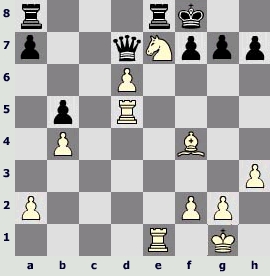
There is a danger not only of 23.¦c5, but also of 23.¦h5. It's easy to parry any of two threats, but not both at a time. Forexampleincaseof 23...f6!? intrusion into h5 is now ineffective, however 24.¦c5 ¦ac8 25.¦:c8 are very strong [pointed by Epishin 25.¦ec1 is worse because of response 25...¦cd8›] 25...¦:c8 26.¤:c8 Ј:c8 27.ўh2!? with subsequent intrusion of the Rook into e7.
23. . . . a7-a6
To 24.¦c5 Black prepared 24...¦a7, and maybe even 24...Јa7!? 25.¦c7?! Јd4. However he is unprotected against an intrusion from the opposite wing.
24.¦d5-h5! f7-f6
The pawn "h", alas, is lost: 24...h6 25.¦:h6!.
25.¦h5:h7 ¦a8-d8
To 25...ўf7 26.Ґh6 turns the scale, and to 25...¦ac8, perhaps, the strongest move is 26.ўf1!.
26.¦e1-e3 ¦d8-c8
27.¤e7:c8
27.¦g3 would also win easily.
27. . . . ўf8-g8
If 27...¦:e3, then 28.¦h8+. And to 27...¦:c8 28.¦e7 finishes the game at once!
28.¤c8-b6! Јd7-d8
29.¦e3:e8+ Јd8:e8
30.d6-d7 Јe8-d8
31.¦h7-h5 g7-g5
31...Ј:b6 32.¦d5 Јd8 33.Ґc7, and the pawn queens.
32.Ґf4-e3 ўg8-g7
33.h3-h4 ўg7-g6
34.¦h5:g5+
Black resigned.
Speelman – Martin A38
Championship of Great Britain, Torkuay 1982
1.¤g1-f3 ¤g8-f6
2.c2-c4 g7-g6
3.g2-g3 Ґf8-g7
4.Ґf1-g2 d7-d6
5.0-0 0-0
6.b2-b3 e7-e5
6...¤e4!? 7.d4 c5 8.Ґb2 ¤c6 9.¤bd2 Ґf5 deserve attention, proceeding to the famous position from another opening system (1.¤f3 ¤f6 2.g3 g6 3.b3).
7.Ґc1-b2
In the opinion of Jonathan Speelman 7.d4?! ed 8.¤:d4 are dubious because of 8...c5!. However after 9.¤b5 the situation is quite unclear: it's possible to sacrifice exchange when occasion offers and to get for it an adequate compensation. This concerns also the variant 8...¤g4 9.h3 c5 10.¤c2 Ґ:a1 11.¤:a1.
7. . . . c7-c5
It's a natural move: Black hampers the advance d2-d4, which enlivens the black-square Bishop of the opponent.
8.¤b1-c3 ¤b8-c6
9.d2-d3
If 9.e3, then 9...Ґf5 (with the danger 10...Ґd3) 10.d3 Јd7.
9. . . . h7-h6
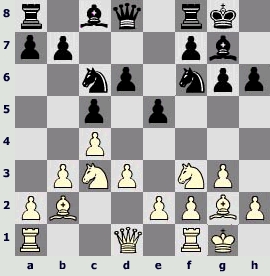
10.e2-e3
White is going to accomplish the development without undertaking dynamic actions in the centre. Here retreats of the Knight f3 with subsequent play along the diagonal h1-a8 have also been tried.
I. 10.¤e1Ґe6 11.¤d5, and now:
11...¤h7 12.¤c2 Јd7 13.Јd2 Ґh3 14.f4 Ґ:g2 15.ў:g2 f5 16.fe de 17.¦f2 ¤g5? [17...¤f6 is better] 18.¦af1 ¦ae8 19.h4 ¤h7 20.e4 ¤d4?! 21.¤:d4 cd?! [21...ed] 22.Ґa3 fe 23.Ґ:f8 e3 24.Јe2 ef 25.Ґ:g7 ў:g7 26.¦:f2± Larsen – Darsil, Buenos Aires 1992 53/60;
11...Јd7 12.Јd2 ўh7 13.f4 ¤g8 14.a3 ¤d4 15.Ґ:d4 ed 16.¤c2 ¦ae8 17.¦ae1 ¤e7= Mails – Vanheste, Diren 1988.
II. 10.¤d2!? In my opinion, the most logical move is when one Knight is striving towards d5, the other one at the convenient moment will occupy the square e4.
10...Ґe6 11.a3 Protecting the square a3, White is preparing ¤d5. Immediate 11.¤d5? Ґ:d5 12.cd ¤b4, in the opinion of Vladimir Tukmakov, gives Black an advantage. This estimation is not quite obvious: White has a right to try a positional sacrifice of a pawn 13.e4!? ¤:d3 14.Ґc3 ¤b4 15.a3 ¤a6 16.f4!? (a preparatory move of the Queen deserves attention) 16...ef 17.gf ¤:d5! (otherwise the position of Black might become uneasy) 18.Ґ:g7 ¤e3 19.Јc1 ¤:f1 20.Ґ:h6 ¤:d2 21.Јc3 f6 22.Ґ:f8 Ј:f8 23.Ј:d2 ¤c7 – there still is a certain compensation for the pawn.
And in the game Dizdar – Damljanovic (Yugoslavia 1990) there was 11.¤de4 ¤e8 12.¤d5 ¦b8 13.¤ec3 a6 14.a3 b5 15.cb ab 16.b4 Јd7 with equality.
11...Јd7 11...d5!? suggested itself, however after 12.cd ¤:d5 13.¦c1 b6 White seizes the initiative by 14.b4! ¤:c3 [no 14...cb? in view of 15.¤:d5 Ґ:d5 16.e4ќ] 15.¦:c3.
12.¤d5 ўh7 13.f4 The position of Black is difficult both in case of 13...Ґ:d5 14.cd±, and in case of the move 13...h5 made in the game Spraggett – Chiburdanidze (Biel 1990), to which there was a possible response 14.fe ¤g4 15.h3 ¤g:e5 16.¤e4 Ґ:d5 17.cd±. The same opportunity remained after 14.¦b1 ¦ae8.
10. . . . Ґc8-f5
10...Ґe6 isn't bad, for example: 11.d4 ed 12.ed d5 13.cd ¤:d5 14.¤a4 cd 15.¤:d4 ¤:d4 16.Ґ:d4 b6= Smyslov – Geller, Moscow 1965, 8th game of the challengers match.
11.h2-h3 Јd8-d7
12.ўg1-h2 ¦a8-b8
12...Ґe6 deserved attention, preparing d6-d5. And in the game Grigoryan – Tukmakov, the championship of the USSR 1977 24/92 12...g5!? 13.¤g1 g4! 14.¤e4 ¤h7 15.f4 gh was played [15...gf 16.¤:f3 led to advantage of White with subsequent ¤h4] 16.¤:h3 Ґg4! [16...Ґe6?! 17.fe ¤:e5 18.Ґ:e5! Ґ:e5 19.d4 Ґg7 20.¤f4 ¤g5 21.¤:g5 hg 22.¤:e6 fe 23.Јg4, and White keeps the initiative] 17.Јd2 f5 18.¤c3 ¦ae8 19.¤f2 Ґh5 20.Ґh3 [20.¦ae1] 20...Јf7! 21.¤d5 Ґf3!, and chances of Black are not worse.
13.Јd1-d2
He should have taken the opportunity of the move 13.¤d5! – Black couldn't exchange the Knights: 13...¤:d5?? 14.cd ¤e7 15.e4, and the Bishop is caught.
13. . . . g6-g5!
Now to 14.¤d5?! there will be a response 14...¤:d5!.
14.¦a1-d1 a7-a6
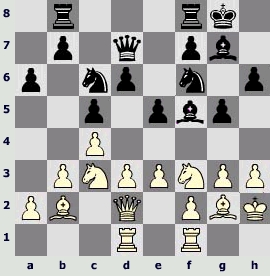
Black has done rather well out of the opening and could even claim a slight space advantage, which White very much wants to challenge with d4. I couldn't see where I was going until the idea of the Queen sacrifice hit me, initially just as fantasy, then, on inspection, as a real possibility (Speelman).
15.d3-d4! c5:d4
Here and the next move it perhaps made no sense for Black to play 15...g4 16.hgІ. However 15...e4 (or 16...e4) deserved a serious attention.
16.e3:d4 e5:d4
17.¤f3:d4!?
The sacrifice of the Queen isn't forced at all. Moreover after 17.¤d5 it's not easy for Black to demonstrate an effective way of equalizing:
17...Ґe4 18.¤:f6+ Ґ:f6 19.¤:d4 Ґ:g2 20.ў:g2І/±;
17...¤e4 18.Јc1 Ґe6 19.Јa1! with unpleasant pressure on the opponent's position [19.¤:d4 Ґ:d5 20.cd ¤:d4= are weaker];
17...¤:d5 18.cd ¤e5 19.¤:d4 Ґg6(h7) 20.f4! ¤d3 21.Ґa1 gf 22.gf, and the position of Black isn't easy.
However from the practical point of view the creative decision of White is quite expedient, because it poses very difficult problems for the less experienced opponent.
17. . . . ¤c6:d4
18.Јd2:d4 ¤f6-g4+
19.h3:g4 Ґg7:d4
20.¦d1:d4

Strategic trumps of White are obvious: pressure on the diagonal a1-h8, active disposition of pieces, and weakness of the pawn d6. Objectively the position of Black is defensible, but a strict accuracy is required of him.
The first difficult problem he was to solve: whether he should take the pawn g4 or not. The advantage of the move 20...Ґ:g4!? is that it makes it possible to play f7-f5 then and when occasion offers f5-f4. For example: 21.¤d5 (!?Speelman) 21...f5, or 21.¤e4 f5 [now no 22.¦:d6? because of 22...fe! 23.¦:d7 Ґ:d7µ] 22.¤:d6 (Speelman) 22...f4 (with a positional danger 23...f3) 23.¦e1!? fg+ 24.ў:g3 Ґh5 [or 24...¦f4] with unclear position.
As Ernesto Inarkiev pointed out 21.c5!? is more dangerous for Black. For example 21...Ґe6?! leads to difficult consequences for him [21...Јf5? 22.¤d5!; 22...f5? 23.¦:d6] 22.¦:d6 Јe7 23.f4! [Worse are 23.¦fe1 Јf6 24.¦e2 Јg6 25.g4 ¦bd8! 26.Ґe4 f5 27.Ґ:f5 Ґ:f5 28.¦:g6+ Ґ:g6µ or 26.¤e4 ¦:d6 27.¤f6+ Ј:f6 28.Ґ:f6 ¦d7›] 23...¦bd8 [23...gf 24.¦:f4 with dangerous threats] 24.f5 Ґ:f5 25.¦:f5 ¦:d6 26.cd Ј:d6 27.¤e4 Јd3 28.¤f6+ ўg7 29.¦f2±.
Apparently, the best defense is: 21...f6! 22.¦:d6 Јe8. The variant 23.¤d5 Јh5+ 24.ўg1 Ґh3 25.Ґ:h3 Ј:h3 26.¤:f6+ ¦:f6 27.¦:f6 Јh5І is also possible.
In the game the pieces of Black remained far more constrained.
20. . . . Ґf5-g6
21.с4-c5
The opponent has to reckon with both 22.cd, and 22.¦:d6 (and then 23.¤d5).
White had at the disposal also other methods of attack. For example the move 21.f4!? is tempting. Black responds 21...f5 [to 21...Ј:g4 22.Ґh3 Јh5 23.f5 are unpleasant] 22.c5 [22.¦fd1 gf 23.¦:d6 gf+ are worse] 22...fg 23.¦:d6 Јe8.

An attempt to catch the Queen by means of 24.¦f2 gf 25.¦e2 ran against a brilliant response 25...Ґe4!! (with the idea ofЈh5+), takes White over a rough road: 26.¦:h6 fg+ 27.ўg1 Ґ:g2 28.¦:e8 ¦b:e8 29.ў:g2 ¦f2+ 30.ў:g3 ¦:b2 or 26.¦d5 fg+ 27.ў:g3 Јf7 28.Ґ:e4 ¦be8°. And more natural attack 24.¤d5 leads to a forced draw after 24...Ґe4 [or 24...Ґd3] 25.¦:h6 Ґ:g2 26.¦h8+ ўf7 27.¦h7+ ўg6 28.¦g7+ ўh5! 29.¦:g5+ ўh6 30.ў:g2 Јe4+ 31.ўg1 Јd3!?.
Certainly such odd variants, which are absolutely impossible to be found and calculated at a board, prove nothing, but merely illustrate a baffling complexity of rendering a decision in the irrational situation.
21. . . . ¦b8-e8
22.¤c3-d5
Speelman rejected 22.¦:d6 because of 22...Ј:g4 23.¤d5 ¦e6!, for example: 24.¤f6+ ¦:f6 25.Ґ:f6 Јe2›. An unclear position arises also in case of 22.¦fd1 ¦e6 23.¦:d6 Јc8 24.b4.
22. . . . f7-f6?!
It would be better to repel the danger of check from f6 by the move 22...¦e6, which strengthens the weak point d6.
23.¤d5-e3
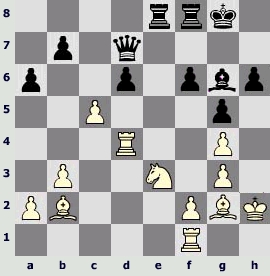
23. . . . Јd7-b5
A sacrifice of exchange is unbeneficial: 23...¦:e3? 24.fe d5 25.Ґ:d5+ ўg7 [25...Ґf7 is refuted by means of 26.¦:f6! Ґ:d5 27.¦g6+ ўh7 28.¦:d5 ¦f2+ 29.ўh3ќ] 26.Ґc4 Јe7 27.¦d6 Ј:e3 28.¦d7+! with a win (Speelman).
In the opinion of the Grand Master this sacrifice involving 23...¦e6 24.¦fd1 deserved attention. But even in this case 24...¦:e3 25.fe Јe7 26.cd give advantage to White. I think Black should not attack е3, but play 24...ўg7!?. In case of 25.cd the situation for Black turns out to be more stable in comparison with the one that was in the game (the Queen kept on blocking the pawn d6). And to 25.¦:d6 there comes a response 25...¦:d6 26.¦:d6 Јb5 27.¤d5 [it's possible to keep the strain, having chosen 27.Ґd4!?] 27...Ј:c5 28.¤:f6 Ј:f2 29.¤h5+ [29.Ґd4 ¦:f6] 29...ўh7 30.Ґd4 Јc2 31.¦d7+ ¦f7 32.¦d8 Ґe4 33.¦h8+ ўg6 34.¦g8+ ўh7 with a draw.
24.c5:d6 Јb5-e2?
A chase of the pawn а2 isn't worthwhile as the passed pawn "d" becomes too dangerous. Speelman justly points that the Queen should have been moved back to the blocked square: 24...Јd7. It's not easy for White to find here a way to advantage. Here is one of the possible variants: 25.¦c1 ¦c8 26.¦:c8 [26.¤c4!? ¦ce8] 26...¦:c8 27.¤d5 Ј:d6 [27...¦f8] 28.¤f4 Јb6 29.¤:g6 ¦c2 30.¤e7+ ўf7 31.¦d7 Ј:f2 32.¤d5+ ўf8 33.¦d8+ with perpetual check. Perhaps slow actions are more unpleasant for Black: 25.¦fd1! and 26.¦1d2 as he can't proceed to counter-attack or dissipate the tension by exchanges.
25.Ґb2-c3 Јe2:a2
26.d6-d7 ¦e8-d8
27.¦d4-d6 ўg8-h7
Having taken the King off the diagonal a2-g8, Black is planning to take the pawn b3. Speelman recommends 27...ўg7!?, but even here the position of Black is difficult: 28.¤d5 Јa3 [after 28...Јc2 or 28...Ј:b3 29.¦e1 turns the scale] 29.¦:f6 [29.¤:f6 Ј:b3 30.¤d5+ ўh7 31.¦e1 ¦:f2 32.¦ee6! Јc2! 33.¤f6+ ўg7 34.¤e4+ ўf7 35.¤:f2 ¦:d7 36.¦f6+ ўe8 37.¦de6+ ¦e7 38.¦:g6± are also possible] 29...ўh7 30.¦a1! Ј:b3 31.¦:f8 ¦:f8 32.¦e1 ¦d8 33.¦e7+ with a won position.
28.¤e3-d5 Јa2-a3
29.b3-b4! Јa3-a4

30.¦f1-a1!
Before putting the Rook at е1, White wants to drive the Queen away from the diagonal a4-e8. Speelman rejected the immediate 30.¦e1 because of 30...¦:d7 31.¦:d7+ Ј:d7. Now 32.¤:f6+ ¦:f6 33.Ґ:f6 Ј:g4 [or 33...ўg8 34.¦e7 Ј:g4] are sufficient only for a draw: 34.¦e7+ [34.Ґd5 Ґf5] 34...ўg8 35.¦g7+ ўf8 36.Ґd5 [36.¦:g6?? Јh5+] 36...ўe8=. That's why it’s better to play 32.¦e7+ Ј:e7 33.¤:e7 (Іaccording to Speelman). In my opinion the advantage of White is considerable, but nevertheless Speelman is right rejecting the simplifications. The result of the struggle can be defined in the middlegame quicker and more effectively.
30. . . . Јa4-b5
After 30...¦:d7 31.¦:f6! Ј:a1 32.¦:f8 or 32.Ґ:a1 are decisive. If 30...Јc2, then the most energetic is 31.¦e1!ќ, though it was possible to play according to Speelman: 31.¤:f6+ ¦:f6 [more stubborn 31...ўg7] 32.Ґ:f6ќ.
31.¦a1-d1
Before taking a piece at f6, White firmly reinforces the pawn "d". A good alternative is 31.¦a5.
31. . . . Јb5-e2
32.¤d5:f6+ ўh7-h8
33.¦d1-e1 Јe2-c4
34.Ґc3-a1!?
The position is so strong that there is no necessity to calculate long forced variants like 34.¤d5+! ўh7 35.¦e7+ ¦f7 36.Ґe4! [36.¦e8 ¦:f2 37.¤f6+ ўg7 38.¤e4+ Ј:c3! are far weaker] 36...Ґ:e4 37.¦:f7+ ўg8 38.¦e7 Ґ:d5 [38...Јf1 39.¦e8+ ўf7 40.¦f6+ ўg7 41.¦ff8+ ўh7 42.¦f7+ ўg6 43.¦g7#] 39.¦e8+ ўf7 [39...ўh7 40.¦:d8 Ј:c3 41.¦f8] 40.¦:d8 Ј:c3 41.¦f8+.
34. . . . Јc4-a2
35.ўh2-g1
35.Ґd4! is a bit more exact.
35. . . . Јa2-c4
If 35...ўg7 (preparing 36...Ј:a1!), then 36.Ґd4ќ.
36.Ґg2-f3
It's the same slow tactics: White is planning 37.ўg2 and when opportunity offers ¦h1. The short cut to the aim is: 36.Ґd5 Јc2 37.¤e8+ ўh7 38.¦e7+.
36. . . . Јc4-b3
37.ўh2-g2
And here it was possible to play 37.¤g8+ ўh7 38.¦:g6 ў:g6 39.Ґe4+ ўf7 40.¤:h6+ ўe6 41.Ґc2+. However in this situation all roads lead to Rome because Black is absolutely helpless.
37. . . . Јb3-c4
38.¤f6-e4+ ўh8-h7
39.¤e4:g5+! h6:g5
40.¦e1-h1+ ўh7-g8
41.¦d6:g6+ ўg8-f7
42.¦g6-g7+
Black resigned.
